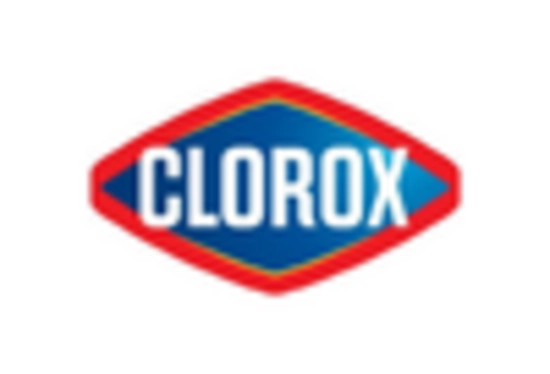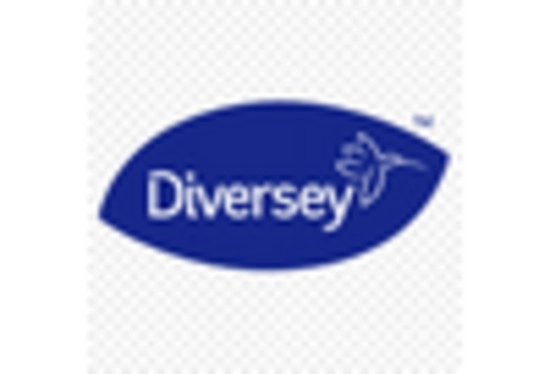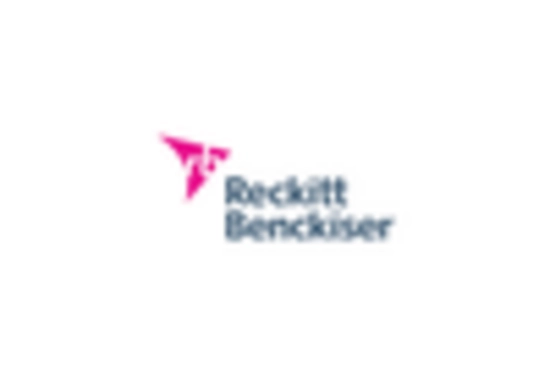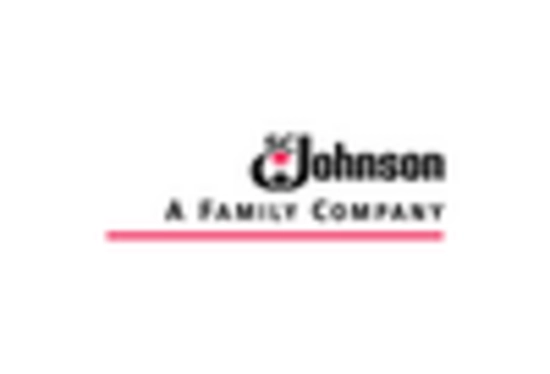The Surface Disinfectant Product Market is currently characterized by a dynamic competitive landscape, driven by heightened consumer awareness regarding hygiene and sanitation. Key players such as Procter & Gamble (US), Reckitt Benckiser (GB), and Ecolab (US) are strategically positioned to leverage innovation and sustainability in their product offerings. Procter & Gamble (US) has focused on enhancing its product portfolio with eco-friendly formulations, while Reckitt Benckiser (GB) emphasizes digital marketing strategies to engage consumers effectively. Ecolab (US) is concentrating on expanding its service offerings in the healthcare sector, which appears to be a significant growth area. Collectively, these strategies not only enhance brand loyalty but also shape a competitive environment that prioritizes sustainability and consumer engagement.
In terms of business tactics, companies are increasingly localizing manufacturing to reduce supply chain vulnerabilities and optimize operational efficiency. The market structure is moderately fragmented, with several players vying for market share. However, the collective influence of major companies like Clorox (US) and Diversey Holdings (US) is notable, as they continue to innovate and adapt to changing consumer preferences. This competitive structure suggests that while there is room for smaller players, the dominance of established brands is likely to persist due to their extensive resources and market reach.
In August 2025, Clorox (US) announced a partnership with a leading technology firm to develop smart disinfecting solutions that utilize AI for enhanced efficacy. This strategic move is indicative of Clorox's commitment to integrating technology into its product offerings, potentially setting a new standard in the industry. The collaboration aims to create products that not only disinfect surfaces but also provide real-time feedback on cleanliness, thereby enhancing user experience and safety.
In September 2025, Reckitt Benckiser (GB) launched a new line of disinfectants that are certified as biodegradable, aligning with the growing consumer demand for sustainable products. This initiative reflects Reckitt's strategic focus on sustainability, which is increasingly becoming a key differentiator in the market. By prioritizing eco-friendly solutions, Reckitt Benckiser (GB) positions itself favorably among environmentally conscious consumers, potentially increasing its market share in a competitive landscape.
In October 2025, Ecolab (US) expanded its global footprint by acquiring a regional disinfectant manufacturer in Southeast Asia. This acquisition is likely to enhance Ecolab's distribution capabilities and product offerings in a rapidly growing market. The strategic importance of this move lies in Ecolab's ability to leverage local expertise and resources, thereby strengthening its competitive position in the region and responding effectively to local market demands.
As of October 2025, current trends in the Surface Disinfectant Product Market indicate a strong emphasis on digitalization, sustainability, and the integration of advanced technologies such as AI. Strategic alliances are increasingly shaping the competitive landscape, allowing companies to pool resources and expertise. Looking ahead, it appears that competitive differentiation will evolve from traditional price-based competition to a focus on innovation, technological advancements, and supply chain reliability. This shift suggests that companies that prioritize these aspects may gain a significant advantage in the market.


















Leave a Comment